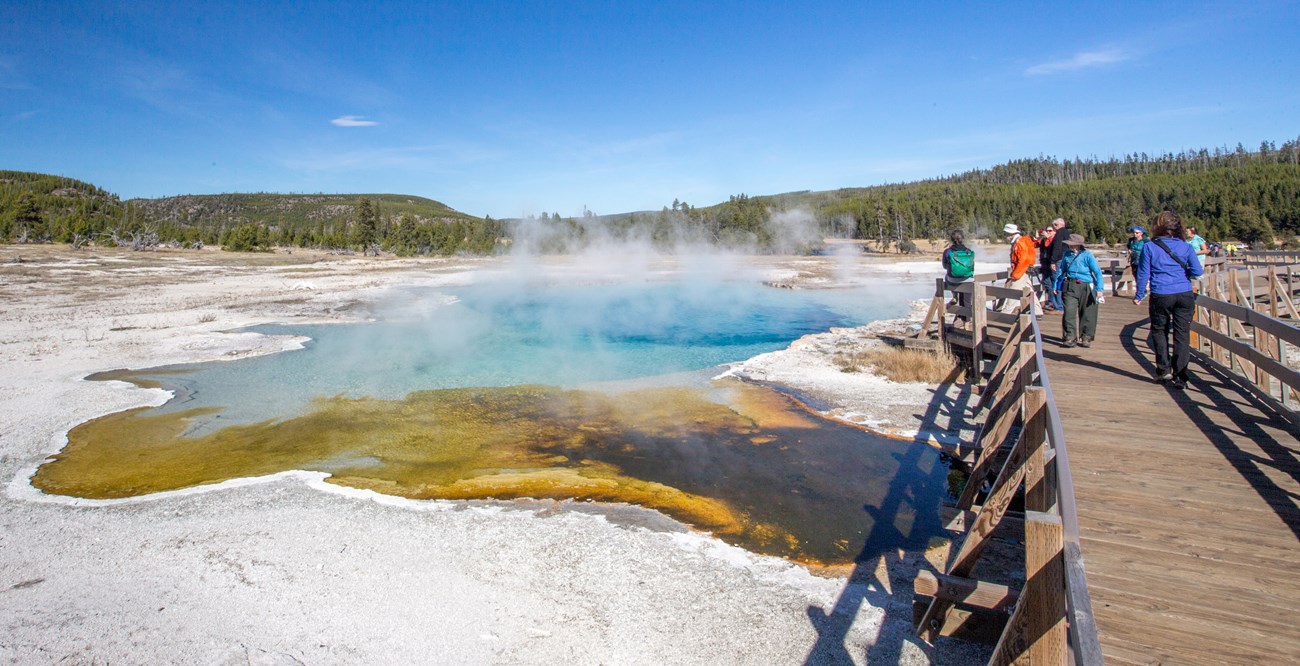
Introduction
Geothermal features can be observed in areas of active volcanism, or areas that have inactive volcanoes. Subsurface magma heats groundwater, creating steam and hot water. The hot, less dense water rises through fissures and cracks in the ground. When it reaches the surface, features such as geysers, fumaroles, hot springs, and mud pits are created.
Geothermal features have great benefits. Geothermal processes create heat and electricity that provide power and hot water to cities in Iceland, New Zealand, Italy and Northern California. As well as being used for energy sources, geothermal waters can also contain minerals and elements such as sulfur, gold, silver, and mercury that can be recovered and used.
Geothermal Features
- Hot springs are heated by geothermal heat—heat from the Earth's interior. In volcanic areas, water may come into contact with very hot rock heated by magma. Hot springs in active volcanic zones may produce superheated water, so hot that immersion can result in injury or death. In non-volcanic areas, the temperature of rocks within the Earth also increases with depth—this temperature increase is known as the Geothermal Gradient. If water percolates deeply enough into the crust, it comes into contact with hot rocks and can circulate to the surface to form hot springs.
- Geysers are the most well known geothermal feature. Each geyser has unique characteristics due to complex internal plumbing. Generally, geysers require that large amounts of groundwater fill underground cavities in an area of volcanic activity. The water in these deep cavities is heated by nearby magma. Suddenly, some of the water flashes into steam and expands rapidly. The overlying water column is forced violently from the vent in an explosion of hot water and steam. This cycle can be repeated regularly. Old Faithful is a geyser in Yellowstone National Park that has erupted once every 65 minutes for hundreds of years!
- Fumaroles are also geothermal features that depend on the interactions of released volcanic gases and the local groundwater system. These occur in areas where a magma conduit passes through the water table. The magma can be liquid or recently solidified, but still hot. The heat from the magma causes water to become steam. As the steam rises it carries volcanic gases such as hydrogen sulfide (H2S) to the surface. This mixture of steam and gas is erupted from vents and fissures in the ground. Due to this chemical activity, fumaroles can be very dangerous. Associated chemical reactions can color the surrounding rocks. Areas with fumarole features are sometimes called "dying volcanoes" because they occur near the end stages of volcanic activity as the magma deep underground solidifies and cools.
- Mudpots are surface features that occur when limited amounts of geothermal water is mixed with mud and clay. Acid and bacteria in the water can dissolve surrounding rock forming viscous pools of bubbling mud.
Featured Video—Yellowstone Geysers
- Duration:
- 5 minutes, 49 seconds
With over half the world's geysers, Yellowstone offers tremendous opportunities to see geology in action. Explore the mechanics of geysers, their role in the park's history and what they can teach us about the world in which we live.
List of Significant Thermal Features in Parks
-
Aniakchak National Monument and Preserve (feature: Aniakchak Caldera (volcanic)).
-
Bering Land Bridge National Preserve (feature: Serpentine Hot Springs (hydrothermal)).
-
Big Bend National Park (including that portion of the Rio Grande National Wild and Scenic River located in the Park) (features: Spring No. 1 (hydrothermal), Spring No. 4 (hydrothermal), Hot Springs (hydrothermal)).
-
Crater Lake National Park (hydrothermal features at bottom of the lake).
-
Gates of the Arctic National Park and Preserve (feature: Reed River Hot Springs (hydrothermal)).
-
Haleakala National Park (feature: Haleakala Crater (volcanic)).
-
Hawaii Volcanoes National Park (features: Steaming Bluff and Sulpher Banks (hydrothermal), Kilauea Caldera and Halemaumau Crater (volcanic), Kilauea Iki Crater (volcanic), Great Crack and Southwest Rift (volcanic), East Rift Zone (volcanic), Chain of Craters (volcanic), Mauna Ulu (volcanic), Puu Oo (volcanic), Mokuaweoweo Caldera and Northeast Rift Zone of Mauna Loa (volcanic)).
-
Hot Springs National Park (feature: Hot Springs (hydrothermal)).
-
John D. Rockefeller, Jr. Memorial Parkway (feature: Huckleberry Hotsprings (hydrothermal)).
-
Katmai National Park and Preserve (feature: Novarupta and vicinity (volcanic)).
-
Lake Clark National Park and Preserve (features: Redoubt Volcano and Iliamna Volcano (volcanic)).
-
Lake Mead National Recreational Area (features: Black Canyon Hotsprings (hydrothermal), Blue Point Spring (hydrothermal), and Rogers Spring (hydrothermal)).
-
Lassen Volcanic National Park (feature: Lassen hydrothermal system including Bumpass Hell, Little Hot Springs Valley, Sulpher Works, Devils Kitchen, Boiling Springs Lake, Drakesbad Hot Springs, and Terminal Geyser)).
-
Mount Rainier National Park (features: Mount Rainier (volcanic), fumaroles at the summit of Mount Rainier and associated Ice Caves (hydrothermal ), and Ohanapecosh Springs (hydrothermal)).
-
Wrangell-St. Elias National Park and Preserve (feature: Wrangell Volcanoes (volcanic)).
- Yellowstone National Park (features: entire park including Old Faithful and approximately 10,000 geysers and hot springs).
Geological Monitoring
Last updated: February 10, 2020
